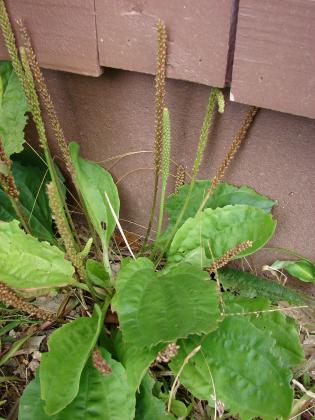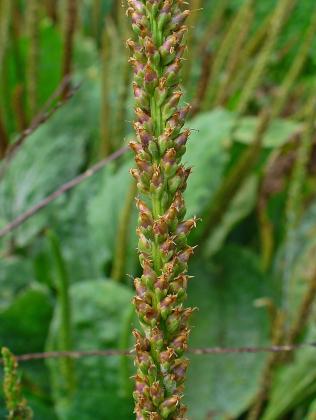Plantago - High fi ber, Hiawatha, Metamucil
Plantago major, broadleaf or common plantain, P. lanceolata, narrow leaf plantain and other species in the Plantago genus, Plantago spp., are not related to the cooking plantain that resembles a banana. Native to Eurasia, Plantago spp. got to North America by hitching a ride from early colonists.
Native Americans called it “white man’s footprint” because it grew around the new settlements and spread wherever people walked. The Song Of Hiawatha, by Henry W. Longfellow is an 1855 epic poem featuring Native Americans. Chapter 21’s title is “White Man’s Foot”:
“Wheresoe’er they tread, beneath them
Springs a flower unknown among us,
Springs the White-man’s Foot in blossom.”
It also springs in Grimes County lawns, fields and sidewalk cracks in cool months. In crops it causes problems for farmers. Plantago is from the Latin word planta, “sole of the foot”. Depending on the species, the leaf is 1 to 2 inches wide resembling a footprint. Leaves grow close to the ground in a rosette and have parallel veins. A seed stalk, 5 to 10 inches tall, has inconspicuous flowers. Seeds are called psyllium, pronounced “si-lee-uhm”.
Psyllium is mucilaginous and used as a dietary fiber and food thickener. You may eat psyllium every day in high-fiber cereal, baked goods, snack bars, frozen desserts, dietary supplements, etc. Leaves are eaten raw, cooked, stuffed, baked crispy as chips, etc. Psyllium fiber and powder are sold in health-related stores and pharmacies. Plantago spp. is in the Food and Drug Administration, FDA, Poisonous Plant Database at fda.gov.
For millennia, wherever it grew, Plantago spp. has been used to treat insect bites, wounds, burns and other skin conditions of humans and animals. It is in wilderness first aid books. The chewed leaf is placed on the skin. It’s used as a “drawing agent” for removing splinters, cleaning wounds, etc. Internally it treats many conditions including both constipation and mild diarrhea. The laxative Metamucil contains psyllium.
Traditional systems used it for diabetes and as a treatment for snake bites. In some places plantain is known as snake weed. It’s called choke weed by some Native American tribes. If someone had a small bone caught in their throat they were given plantain-thickened water. The plant would “draw” the bone so that it could be swallowed or coughed up. Many more uses can be found at the Native American Ethnobotany Database at naeb.brit.org.
Following are some plantain titles from the National Institutes of Health at ncbi. nlm.nih.gov:
• “Immunoenhancing properties of Plantago major leaf extract”.
• “Chemical constituents and medical benefits of Plantago major”.
• “Hepatoprotective and anti-inflammatory activities of Plantago major L”.
In 2014 the U.S. Department of Agriculture approved a Qualified Health Claim, QHC, for psyllium being a benefit for people with diabetes. A company using the QHC must use the FDA-approved wording on their label: “Psyllium husk may reduce the risk of type 2 diabetes, although the FDA has concluded that there is very little scientific evidence for this claim.” The information is from Wikipedia’s “Psyllium” article at en.wikipedia.org.


